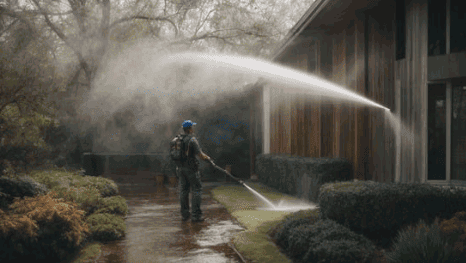
Are you tired of scrubbing the walls of your home? Do you wish there was an easier and more efficient way to clean them? Well, you're in luck because pressure washing the interior walls of your home is a game-changer. Say goodbye to tedious scrubbing and hello to a sparkling clean home in no time!
Table of Contents
Pressure washing is a cleaning method that uses high-pressure water spray to remove tough dirt, grime, mold, and other impurities from surfaces. It is commonly used to clean buildings, concrete surfaces, and outdoor furniture. The high pressure of the water effectively removes stubborn stains and debris, making it an efficient and powerful cleaning technique.
Check out: How To Clean Industrial Concrete Floors
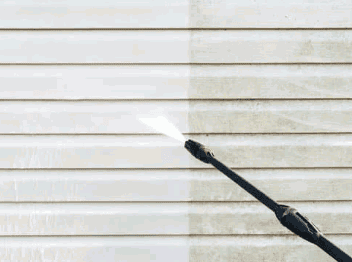
Pressure washers are a powerful and versatile cleaning tool, but not all pressure washers are created equal. In this section, we will discuss the different types of pressure washers and their unique features. From electric to gas, hot water to cold water, each type has its own strengths and limitations. By understanding the differences between these pressure washers, you can determine which one is best suited for your cleaning needs. Let's dive in and explore the various options available.
Compact and Portable: Electric pressure washers are typically smaller and lighter than gas models, making them easier to maneuver and store.
Quiet Operation: They produce less noise than gas pressure washers, making them suitable for noise-sensitive areas.
Low Maintenance: No need to change oil or perform regular maintenance, providing convenience and cost savings.
Eco-Friendly: They produce zero emissions, contributing to a cleaner environment.
Simple Start-Up: Just plug in and switch on, eliminating the hassle of manual priming or pulling cords.
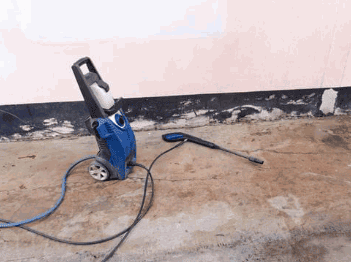
Gas pressure washers are powerful tools ideal for heavy-duty tasks like cleaning large areas, decks, and driveways. These washers are portable and do not require an electrical outlet, offering flexibility in outdoor cleaning projects. They provide high pressure and flow rates, making them efficient for tackling stubborn grime and dirt. Gas pressure washers are available in various models, offering different pressure levels and nozzle options for versatile cleaning.
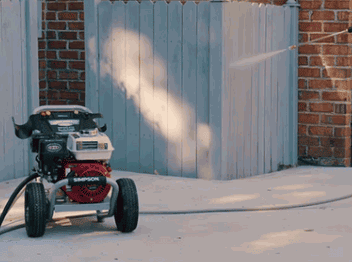
Hot water pressure washers utilize heated water, enhancing cleaning efficacy. These work well for removing grease, oil, and tough deposits. Adjust temperature settings based on the surface to be cleaned. Use protective gear when operating hot water pressure washers. Regular maintenance is vital to ensure optimal performance and longevity.
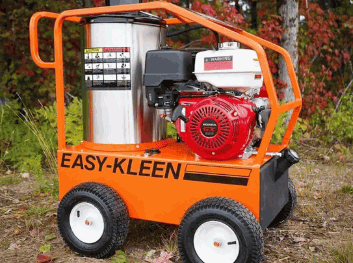
Efficient cleaning: Cold water pressure washers efficiently remove dirt, grime, and mud from various surfaces.
Versatility: They are suitable for cleaning outdoor surfaces like sidewalks, driveways, and decks.
Cost-effective: Cold water pressure washers are generally more affordable than hot water pressure washers.
Environmentally friendly: They do not require heating, which reduces energy consumption and makes them eco-friendly.
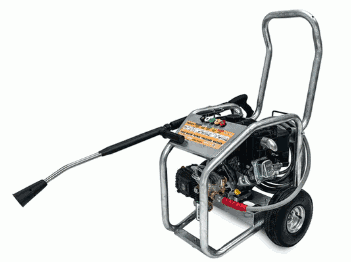
Pressure washing is a popular method of cleaning various surfaces, but what exactly are the benefits of this technique? In this section, we will discuss the advantages of pressure washing and how it can benefit both you and the environment. From efficient cleaning to saving time and effort, pressure washing offers a variety of benefits that make it a preferred choice for many. Additionally, we will explore how pressure washing is an environmentally friendly option for keeping your surfaces clean and well-maintained.
Clear the area: Remove any obstacles or items that might be damaged by the pressure washing.
Inspect the walls: Check for any cracks, loose paint, or damage that could be worsened by pressure washing.
Select the right pressure washer: Ensure you have the appropriate pressure washer for interior walls, such as an electric or low-pressure washer.
Prepare the cleaning solution: Use a mild detergent or specially formulated cleaner suitable for interior walls.
Test on a small area: Before proceeding, test the pressure and cleaning solution on a small, inconspicuous section to ensure it doesn't damage the wall.
Prepare the area by covering electrical outlets and removing any items that could be damaged by water.
Choose the right pressure washer and nozzle suitable for interior walls.
Test the pressure on an inconspicuous area to ensure it doesn't damage the surface.
Start pressure washing from the top and work your way down in a consistent and controlled manner.
Rinse the walls thoroughly to remove any detergent or residue.
Use biodegradable and eco-friendly detergents to minimise environmental impact.
Opt for pressure washers with water-saving features to conserve water.
Properly dispose of wastewater to prevent contamination of water bodies.
Pressure washing interior walls is not recommended as it can cause damage to the drywall, plaster, or paint. The force of the water can lead to moisture seeping into the walls, resulting in mould or mildew growth. Instead, use gentle cleaning methods like wiping with a damp cloth or using a mild detergent solution to maintain the interior walls' cleanliness and integrity.
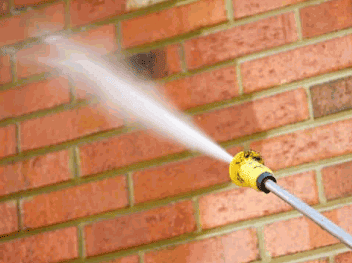
When pressure washing interior walls, it's crucial to consider potential risks and take necessary precautions. Some risks include water seepage, paint damage, and electrical hazards. To mitigate these, inspect the walls for vulnerabilities, cover electrical outlets, and use low pressure and the appropriate cleaning solution. Protective gear such as goggles and gloves should also be worn to prevent injury from splashing water or cleaning chemicals.
Pressure washing is a popular and effective method for cleaning various surfaces, but can it be used on interior walls? The answer is yes, but it requires a different approach than exterior surfaces. In this section, we will discuss the proper steps for pressure washing interior walls, including preparing the area, selecting the right equipment and nozzle, testing the pressure, and the proper technique for washing and rinsing the walls. By following these steps, you can effectively clean your interior walls without causing any damage.
Clear the area: Remove any furniture, decorations, or items from the walls that could obstruct the cleaning process.
Protect surfaces: Cover electrical outlets, switches, and other non-washable surfaces with plastic or tape to prevent water damage.
Ventilate the area: Open windows or use fans to ensure proper ventilation during and after the pressure washing process.
Assess the cleaning task: Determine the pressure needed based on the surface material and the type of grime or dirt.
Select the appropriate pressure washer:
Choose the right nozzle:
Use a wider nozzle for delicate surfaces and a narrower nozzle for tougher stains.
Before pressure washing, test the pressure on an inconspicuous area to ensure it doesn't damage the surface.
Prepare the area by removing any obstacles and covering electrical outlets and switches.
Choose the right pressure washer and nozzle suitable for interior walls, ensuring it's set to low pressure.
Test the pressure on an inconspicuous area to avoid any damage or paint peeling.
Start pressure washing from the top, working your way down in smooth, overlapping strokes.
Rinse the walls thoroughly with clean water to remove any residue.
Use a low-pressure setting and thoroughly rinse the walls to remove all cleaning solutions. Ensure that all residue and dirt are completely washed away.
Inspect the walls to confirm that they are free from any remaining grime or detergent.
While pressure washing is a popular method for cleaning exterior surfaces, it may not always be suitable for interior walls. So, what alternatives do we have for cleaning interior walls? In this section, we will discuss three alternatives to pressure washing: hand scrubbing, steam cleaning, and chemical cleaners. Each method has its own advantages and considerations, and we will explore them in detail to help you determine the best approach for your interior walls.
Prepare the cleaning solution by mixing water and mild detergent.
Dip a soft-bristle brush or sponge into the solution.
Gently scrub the interior walls using circular motions, starting from the top and working downwards.
Rinse the walls with clean water and a separate sponge or cloth.
Dry the walls using a soft, absorbent towel.
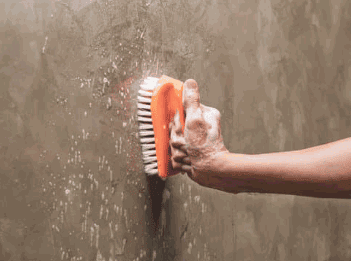
Prepare the area by removing any furniture or items from the walls and covering the floor to protect it from moisture and cleaning agents.
Choose the right steam cleaner suitable for the walls, ensuring it has adjustable pressure settings and appropriate attachments.
Test the steam pressure on a small area to ensure it doesn't damage the wall surface or paint.
Start steam cleaning from the top of the wall, working your way down in a systematic pattern to ensure complete coverage.
Rinse the walls thoroughly after steam cleaning to remove any residue and cleaning agents.
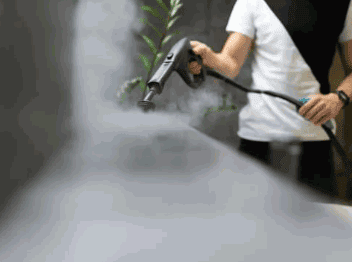
Assess the surface: Determine the material of the wall and the specific type of dirt or grime present.
Select the appropriate cleaner: Choose a chemical cleaner suitable for the wall material and the type of stains to be removed.
Dilute the cleaner: Follow the manufacturer's instructions to dilute the chemical cleaner to the correct concentration.
Apply the cleaner: Use a sprayer or sponge to apply the chemical cleaner evenly across the surface of the wall.
Allow dwell time: Let the cleaner sit on the wall for the recommended period to effectively break down the dirt and stains.
Rinse thoroughly: After the dwell time, rinse the wall with water to remove all traces of the chemical cleaner.